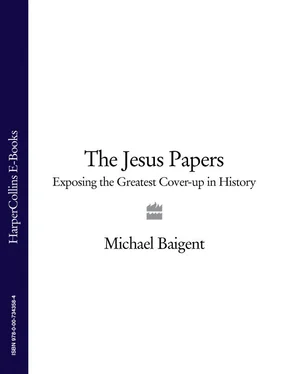| c. A.D. 55-120 |
Life of Tacitus, Roman historian and senator, who mentions Christ. |
| c. A.D. 61-c. 114 |
Life of Pliny the Younger, who mentions Christ. |
| c. A.D. 115 |
Ignatius, bishop of Antioch, quotes from letters of Paul. |
| A.D. 115 |
Revolt in Alexandria is led by Lucuas, the “King of the Jews.” The Jewish community in Egypt is destroyed. |
| c. A.D. 117-138 |
Writing years of Suetonius, Roman historian, who mentions “Chrestus.” |
| c. A.D. 120 |
The Gnostic teacher Valentinus is educated in Alexandria. |
| A.D. 131-135 |
Simon Bar Kochba leads revolt in Judaea. |
| A.D. 133 |
Nine to twelve Roman legions invade Judaea from the north. |
| A.D. 135 |
Jewish forces are defeated. The Roman emperor Hadrian changes the name of Judaea to Palaestina (now Palestine). |
| c. A.D. 135 |
The Christian theologian Justin Martyr argues with the Jewish intellectual Trypho. |
| c. A.D. 140 |
Marcion arrives in Rome and begins teaching. He rejects the Old Testament and uses only Luke’s Gospel and some of Paul’s letters. |
| c. A.D. 150 |
First Christian writers begin to condemn the Gnostics. |
| A.D. 154 |
Justin Martyr names Simon Magus (mid-first-century A.D.) the source of all heresies. |
| c. A.D. 180 |
Irenaeus, bishop of Lyons, writes against the Gnostics. Produces the first list of texts for a canonical New Testament. |
| c. A.D. 195 |
Clement, bishop of Alexandria, writes about the secret Gospel of Mark and against the Gnostics, but maintains a sympathy for the secrets, mysteries, and initiations within Alexandrian Christianity. |
| c. A.D. 197 |
Tertullian converts to Christianity; is militantly opposed to heresy and to women in leadership roles in the Church. |
5 Creating the Jesus of Faith
Modern Christian illustrations depict the popular image of Jesus wandering around ancient Israel—the sun gilding his blond hair yet never burning his fair skin. They portray him as a Christian missionary accompanied by his disciples, some of whom were already scribbling down their Gospels in order to record the sacred words of a living god.
We have already pointed out the obvious flaw in this picture: Jesus was a Jew. He was a dark Palestinian, not a fair northern European. But there is another profound error in this image, one equally significant but less well known: there was no such thing as a gospel at the time, let alone a “New Testament”; there was no “Christianity.” The sacred books that Jesus and his disciples used were those of Judaism—as is immediately apparent to anyone who reads the New Testament and notes how familiar Jesus was with the Judaic scriptures, the ease with which he quoted from them, and the assumption of familiarity on the part of his audience—presuming, of course, that the events depicted in the Gospels actually happened.
Because we’ve always been told with such confidence that the various Gospels had been written by the latter part of the first century A.D., it is a surprise to discover that there wasn’t a New Testament in existence at the beginning of the second century A.D. Or even by the end of that century, although by that time some theologians, nervous about what they considered to be the “truth,” were attempting to create one. Despite these theologians’ best efforts, Christians had to wait almost two more centuries for an agreed-upon text. So what was it that they were really waiting for?
This delay in arriving at an official collection of Christian texts calls into serious question the widespread Christian belief over the last 1,500 years that every word in the New Testament is a faithful transmission from God himself. To an independent observer, it seems more likely not only that the New Testament was deliberately imposed upon a god who was actually quite happy with a wide expression of teachings, but that it was deliberately imposed by a group of people who wished to control the divine expression for their own profit and power.
The delay, as it happens, occurred while the theology was catching up with the demand for a centralized orthodoxy. Until key decisions were made with regard to the divinity of Jesus, the leaders of the Church lacked the officially sanctioned criteria by which to choose the texts designed to represent their newly created religion.
Even more crucially, many people today consider the New Testament texts sacrosanct. They believe them to be the divine words of God written as the only means by which we might be saved, words that cannot be changed or taken in any other way than literally. No one has ever told them that this was not the intention of the early compilers of the traditions about Jesus that make up the collection. In fact, for the first 150 years of the Christian tradition the only authoritative writings were those books now called the “Old Testament.” 1
A good example of the early attitude toward scripture is given by the second-century Christian writer Justin Martyr. For him our so-called Gospels were simply memoirs of the various apostles that could be read in church and used in support of the faith but were never considered as “Holy Scripture.” The term “Holy Scripture” was reserved for the books of the law and the prophets—that is, the Old Testament. Bluntly, Justin Martyr “never considers the ‘Gospels’ or the ‘Memoirs of the Apostles’ as inspired writings.” 2 Justin reached the pinnacle of sainthood, but his position would be considered radical if held by any member of the Christian Church today.
It is certainly true, however, that during the later first century and the entire second century A.D., traditions about Jesus began to be recorded. Sayings and stories about the events of his life were collected, but none were deemed the official or authorized collection at that time. It is also true that the texts that now appear in our New Testament were written in that span. During the late first and second centuries A.D., the whole concept of “Christianity” crystallized out of messianic Judaism, and this leads us immediately to a number of logistical challenges, some of them quite radical.
A curious phenomenon began in the second century B.C.: the Aramaic word meshiha —messiah—which is otherwise devoid of any explanation, began to be used as the name of the true ruler of Israel. In particular, it denoted the expected king of the royal Line of David. 3 A general hope that a descendant of King David would arrive found expression in the books of the prophets in the Old Testament. Thus, the Christian use of the term christos , or “Christ,” a Greek translation of the Aramaic meshiha , along with the transliteration into Greek Messias —now “messiah”—came from a Jewish context and usage that was already well understood by Jesus’s day. 4
The most radical logistical challenge is answering a charge that has regularly been made, particularly over the last 150 years: that Jesus didn’t exist at all and the stories about him are simply tales of various messianic leaders that were later gathered together in order to justify, first a Pauline position, and later, a Roman-centered tradition wherein the Jewish messiah was turned into a deified imperial figure, a kind of royal angel. William Horbury, reader in Jewish and Early Christian Studies at Cambridge University, recently noted, “A cult of angels…accompanied the development of the cult of Christ.” 5
Can we really be sure that Jesus existed? Is there any proof of his reality beyond the New Testament? If not, if the New Testament was put together long after his time, how do we know that the whole concept of Jesus Christ is not just an ancient myth given a new spin? Perhaps it was some rewriting of the Adonis myth or the Osiris myth or the Mithras myth: all three were born of a virgin and raised from the dead—a familiar story to Christians.
Читать дальше












